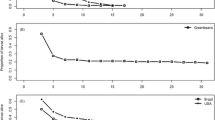Summary
Feeding efficiencies of ultimate instar larvae of two polyphagous tree-feeding Lepidoptera, Malacosoma disstria (Lasiocampidae) and Orgyia leucostigma (Liparidae), were measured on artificial diets containing from 0% to 8% tannic acid. Relative growth rate (RGR) of O. leucostigma was not affected by up to 8% tannic acid, suggesting that O. leucostigma has evolved an effective counteradaptation to hydrolyzable tannins. In contrast, as little as 0.5% tannic acid caused a significant reduction in RGR of M. disstria, due both to reduced efficiency of conversion of digested food (ECD) and reduced relative consumption rate (RCR), and caused a significant increase in mortality during the pupal stage. Moreover, when reared from hatching on tannin-containing diets, no M. disstria larvae survived past the fourth instar.
Although tannins are commonly referred to as “digestibility-reducing substances”, tannic acid did not reduce the ability of M. disstria or O. leucostigma larvae to digest either the whole diet or nitrogen contained in the diet. For M. disstria, tannic acid acts as a toxin and a feeding deterrent, but not as a digestibility-reducing substance. Growing evidence that tannins commonly act as toxins warrants a reassessment of their role in anti-herbivore chemistry.
Similar content being viewed by others
References
Baker WL (1972) Eastern forest insects. U.S.D.A. Forest Service misc. publ. 115. p 642
Berenbaum M (1980) Adaptive significance of midgut pH in larval Lepidoptera. Am Nat 115:138–146
Berenbaum M (1983) Effect of tannins on growth and digestion in two species of papilionids. Ent Exp Appl 34:245–250
Bernays EA (1978) Tannins: an alternative viewpoint. Ent Exp Appl 24:44–53
Bernays EA (1981) Plant tannins and insect herbivores: an appraisal. Ecol Ent 6:353–360
Bernays EA, Woodhead S (1982) Plant phenols used as nutrients by a phytophagous insect. Science 216:201–203
Bernays EA, Chamberlain DJ, McCarthy P (1980) The differential effects of ingested tannic acid on different species of Acridoidea. Ent Exp Appl 28:158–166
Bernays EA, Chamberlain DJ, Leather EM (1981) Tolerance of acridids to ingested condensed tannin. J Chem Ecol 7:247–256
Feeny P (1970) Seasonal changes in oak leaf tannins and nutrients as a cause of spring feeding by winter moth caterpillars. Ecology 51:565–581
Feeny P (1976) Plant apparency and chemical defense. Rec Adv Phytochem 10:1–40
Games PA, Howell JF (1976) Pairwise multiple comparison procedures with unequal N's and/or variances: A Monte Carlo study. J Ed Stat 1:113–125
Gornitz K van (1954) Fraßauslösende Stoffe für polyphagene Holzgewächse fressender Raupen. Verhandlungen der Deutschen Gesellschaft für Angewandte Entomologie e.V. 6:38–47
Hagerman A, Butler L (1978) Protein precipitation method for the quantitative determination of tannins. J Agr Food Chem 28:809–812
Haslam E (1979) Vegetable tannins. Rec Adv Phytochem 12:475–524
Klocke JA, Chan BG (1982) Effects of cotton condensed tannin on feeding and digestion of the cotton pest, Heliothis zea. J Insect Physiol 28:911–915
Manuwoto S, Scriber JM (1986) Effects of hydrolyzable and condensed tannin on growth and development of two species of polyphagous Lepidoptera. Spodoptera eridania and Callosamia promethea. Oecologia 69:225–230
Manuwoto S, Scriber JM, Hsia MT, Sunargo P (1985) Antibiosis/antixenosis in tulip tree and quaking aspen leaves against the polyphagous southern armyworm, Spodoptera eridania. Oecologia 67:1–7
Martin JS, Martin MM (1983) Tannin assays in ecological studies. Precipitation of ribulose-1,5-biphosphate carboxylase/oxygenase by tannic acid, quebracho, and oak foliage extracts. J Chem Ecol 9:285–294
Martin MM, Martin JS (1984) Surfactants: their role in preventing the precipitation of proteins by tannins in insect guts. Oecologia 61:342–345
Martin JS, Martin MM, Bernays EA (1987) Failure of tannic acid to inhibit digestion or reduce digestibility of a plant protein in the gut fluids of insect herbivores: implications for theories of plant defense. J Chem Ecol 13:605–621
Muggli JM (1974) Sex identification of Malacosoma disstria pupae (Lepidoptera: Lasiocampidae). Ann Ent Soc Am 67:521–522
Reese JC, Chan BG, Waiss AC (1982) Effects of cotton condensed tannin, maysin (corn) and pinitol (soybeans) on Heliothis zea growth and development. J Chem Ecol 8:1429–1436
Rhoades D, Cates R (1976) Towards a general theory of plant antiherbivore chemistry. Rec Adv Phytochem 10:168–213
Sokal R, Rohlf FJ (1981) Biometry. W.H. Freeman and Co. San Francisco, p 859
Stehr FW, Cook EF (1968) A revision of the genus Malacosoma Hubner in North America (Lepidoptera: Lasiocampidae): Systematics, biology, immatures, and parasites. US Nat Mus Bull 276:1–319
Steinly B, Berenbaum M (1985) Histopathological effects of tannins on the midgut epithelium of Papilio polyxenes and Papilio glaucus. Ent Exp Appl 39:3–9
Swain T (1979) Tannins and lignins. In: Rosenthal GA, Janzen DH (eds) Herbivores: Their Interactions With Secondary Plant Metabolites, Academic Press, New York, pp 657–682
Waldbauer G (1968) The consumption and utilization of food by insects. Adv Insect Physiol 5:229–288
Author information
Authors and Affiliations
Rights and permissions
About this article
Cite this article
Karowe, D.N. Differential effect of tannic acid on two tree-feeding Lepidoptera: implications for theories of plant anti-herbivore chemistry. Oecologia 80, 507–512 (1989). https://doi.org/10.1007/BF00380074
Received:
Issue Date:
DOI: https://doi.org/10.1007/BF00380074




